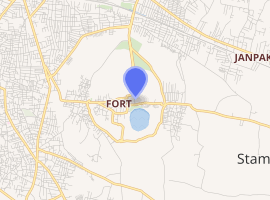Kakatiya Kala Thoranam
Kakatiya Kala Thoranam (also called Warangal Gate) is a historical arch in the Warangal district, of the Indian state of Telangana. The Warangal Fort has four ornamental gates which originally formed the gates to the destroyed great Shiva temple which are known as Kakatiya Kala Thoranam or Warangal Gates. The architectural feature of these historical arches of the Warangal Fort has been adopted as the symbol of the Kakatiya Dynasty and has been officially incorporated as the Emblem of Telangana for the state of Telangana.[1] These gates or arches in the Warangal Fort are said to have similarities with gateways of the Sanchi stupa; this fact has been endorsed by many.[2]
| Kakatiya Kala Thoranam | |
|---|---|
 | |

| |
| General information | |
| Type | Arch |
| Location | Warangal, Telangana, India |
| Completed | circa 1200 CE |
The arch was built around 12th century during the rule of the Kakatiya dynasty.[3] The Monument was included in the "tentative list" of UNESCO World Heritage Site. The Monument was submitted by the Permanent Delegation of India to UNESCO on 10/09/2010.[4][5]
History
_and_Ruins.jpg)
The Kakatiya Kala Thoranam, or arch, is an extensive ornamented stone sculpture; reflective of four identical gates in the Warangal Fort, which was part of the great Swayambhusiva temple of Shiva in the fort built by Ganapati Deva (1199-1262) during the 12th century.[6] His daughter Rudrama Devi and Pratap Rudra II of the Kakatiya Dynasty added more fortifications to the fort which was laid in three concentric circles.[7] The four gateways (charkamou) were part of the temple which was destroyed by the Muslim invader Ulugh Khan during the 1323 invasion, as a part of their policy followed after their victories over territories, to desecrate Hindu temples.[7] The great temple of which the gates were integral is said to be comparable to the size and splendor of the Rudra Mahalaya Temple at Siddhpur in Gujarat.[8]
Features
A depiction of the arch forms the main symbol in the Emblem of Telangana for the state of Telangana.[9][10] This logo or emblem, in English, Telugu and Urdu is portrayed with a combination of green and gold, representing "Bangaru Telangana" (meaning: "Golden Telangana"). Also inscribed on the logo are the names of the Government of Telangana in English, and as "Telangana Prabhutvam" in Telugu and as "Telangana Sarkar" in Urdu. At the base of the logo there is an inscription in Sanskrit which says "Satyameva Jayate" (meaning: Truth shall triumph).[1]
The central part of the fort, identified as the archaeological zone, contains the ruins of the great Swayambhusiva temple, now seen with only the free-standing "Entrance Portals", or gates on the four sides, all being similar in design. Each gate has twin pillars with angled brackets over which lies the huge lintel; the height of this gate being 10 metres (33 ft). The gates have extensive intricate carvings of "lotus buds, looped garlands, mythical animals, and birds with foliated tails". They do not depict any religious symbols, said to be the reason for its preserved condition for not being destroyed by Muslim invaders.[11][8] The gates at the northern and southern ends are 480 feet (150 m) apart. The eastern and western gates are at a distance of 433 feet (132 m) apart.[8]
References
- "Kakatiya arch, Charminar in Telangana state logo". The Deccan Chronicle. 30 May 2014. Retrieved 1 July 2015.
- Prasādarāvu 1989, p. 35.
- "Telangana government launches its own logo". Business Today. 31 May 2014.
- Centre, UNESCO World Heritage. "The Qutb Shahi Monuments of Hyderabad Golconda Fort, Qutb Shahi Tombs, Charminar - UNESCO World Heritage Centre". whc.unesco.org.
- "Archived copy". Archived from the original on 22 June 2018. Retrieved 3 December 2017.CS1 maint: archived copy as title (link)
- Singh 2007, p. 297.
- Eaton 2005, p. 20.
- Cousens 1900, p. 47.
- "Charminar, Kakatiya arch in 'T' logo". The Hindu.
- "Has Telangana government got the emblem wrong?". The Times of India.
- Michell 2013, p. 296.
Bibliography
- Cousens, Henry (1900). Lists of antiquarian remains in His Highness the Nizam's territories. Office of the superintendent of government printing, India.CS1 maint: ref=harv (link)
- Eaton, Richard M. (17 November 2005). A Social History of the Deccan, 1300-1761: Eight Indian Lives. Cambridge University Press. ISBN 978-0-521-25484-7.CS1 maint: ref=harv (link)
- Michell, George (1 May 2013). Southern India: A Guide to Monuments Sites & Museums. Roli Books Private Limited. ISBN 978-81-7436-903-1.CS1 maint: ref=harv (link)
- Prasādarāvu, Calasāni (1989). Kakatiya Sculpture: A Critical Study of the Sculptural and Artistic Relics and Monuments of Telangana During the Years 1,000 to 1,323 A.D. Under the Kakatiya Rulers. Rekha.CS1 maint: ref=harv (link)
- Singh, Sarina (2007). South India. Lonely Planet. ISBN 978-1-74104-704-2.CS1 maint: ref=harv (link)